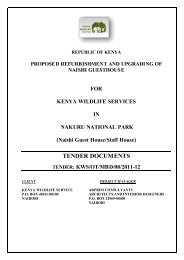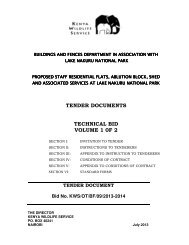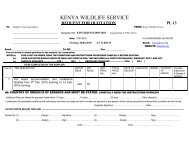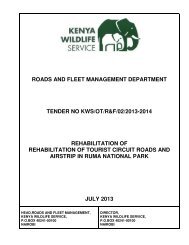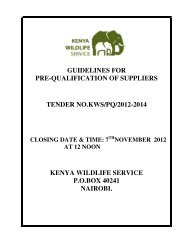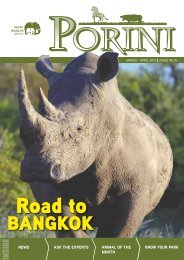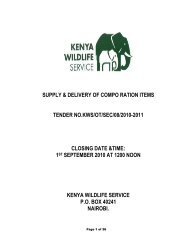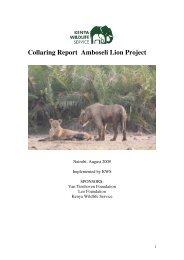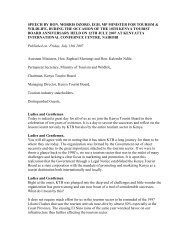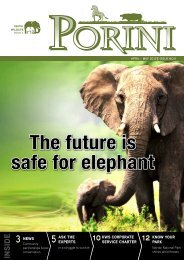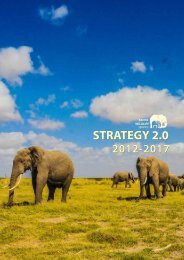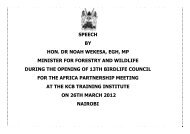Conservation and Management Strategy for the Elephant in Kenya
Conservation and Management Strategy for the Elephant in Kenya
Conservation and Management Strategy for the Elephant in Kenya
Create successful ePaper yourself
Turn your PDF publications into a flip-book with our unique Google optimized e-Paper software.
CONSERVATION AND MANAGEMENT STRATEGY FOR THE ELEPHANT IN KENYA 41<br />
Concern has been expressed by stakeholders <strong>and</strong> wildlife managers <strong>in</strong> many parts of Africa about <strong>the</strong> impact that<br />
elephants are perceived to have on plant <strong>and</strong> animal species when <strong>the</strong>ir density is high, <strong>and</strong> <strong>the</strong>ir habitat is thus<br />
considered to be ‘overpopulated’ (Balfour et al., 2007). The negative effects of high elephant density on habitats are<br />
often associated with fenced populations, such as <strong>in</strong> South Africa, where dispersal is blocked (Guldemond & van<br />
Aarde ,2008). Fences are certa<strong>in</strong>ly a barrier, but elephant populations may also be conf<strong>in</strong>ed through <strong>the</strong> effects of<br />
poach<strong>in</strong>g <strong>and</strong> conflict with people over l<strong>and</strong> use, which causes elephants to retreat <strong>in</strong>to <strong>and</strong> rema<strong>in</strong> <strong>in</strong> PAs, a process<br />
that has been termed ‘compression’, but could be more accurately described as ‘movement restriction’ or ‘<br />
threat-avoidance’. In situations where elephants become completely unable to disperse from a given habitat area,<br />
<strong>the</strong>ir effects on vegetation, <strong>and</strong> on animal species dependent on that vegetation, will <strong>in</strong>evitably become<br />
pronounced <strong>and</strong> of potential concern to managers. The alteration of plant <strong>and</strong> animal communities by elephants is<br />
not necessarily <strong>the</strong> ‘crisis’ often portrayed <strong>in</strong> <strong>the</strong> media, if <strong>the</strong> effects are localised <strong>and</strong> <strong>the</strong> o<strong>the</strong>r species that are<br />
affected are common elsewhere <strong>in</strong> <strong>the</strong> l<strong>and</strong>scape or, more broadly, <strong>in</strong> <strong>Kenya</strong>. Change through time <strong>and</strong> geographical<br />
patch<strong>in</strong>ess are, after all, <strong>the</strong> ways that natural ecosystems work (Gillson, 2004). There are also critical issues associated<br />
with o<strong>the</strong>r changes <strong>in</strong> plant communities which are often caused by human <strong>in</strong>terventions voluntary or<br />
<strong>in</strong>voluntary, such as <strong>in</strong>vasive alien plant species which have an equally significant impact. However, when <strong>the</strong><br />
trapp<strong>in</strong>g of elephants <strong>in</strong>side small areas leads to <strong>the</strong> loss of important, even endangered plant <strong>and</strong> animal species,<br />
remedial actions must be considered. Intensive management <strong>in</strong>terventions, <strong>in</strong>clud<strong>in</strong>g translocation of elephants,<br />
contraception, clos<strong>in</strong>g or mov<strong>in</strong>g of water supplies <strong>and</strong> fenc<strong>in</strong>g of habitat areas, are different options <strong>for</strong><br />
manipulat<strong>in</strong>g local elephant densities <strong>and</strong> each has its benefits <strong>and</strong> costs, its advantages <strong>and</strong> undesirable<br />
consequences. The primary goal of management should be to ma<strong>in</strong>ta<strong>in</strong> <strong>the</strong> mobility of populations through<br />
preservation of corridors <strong>in</strong> elephant-human l<strong>and</strong>scapes. <strong>Conservation</strong>ists of <strong>the</strong> Asian elephant have recognised<br />
this need <strong>for</strong> corridors to l<strong>in</strong>k habitat areas as a key component of <strong>the</strong>ir approach. It is now of crucial importance that<br />
KWS <strong>in</strong>tensifies its programme of community <strong>and</strong> l<strong>and</strong>owner engagement, <strong>and</strong> harmonisation of policy with o<strong>the</strong>r<br />
development sectors <strong>in</strong> governmental <strong>and</strong> non-governmental circles, to secure wildlife habitat. At <strong>the</strong> o<strong>the</strong>r end of<br />
<strong>the</strong> scale, <strong>in</strong> <strong>the</strong> case of very small habitat areas, which have never normally held significant, year-round elephant<br />
densities, which may conta<strong>in</strong> plant or animal species of high conservation importance <strong>and</strong> which have become<br />
enclosed through <strong>the</strong> conversion of surround<strong>in</strong>g habitat, <strong>the</strong>re comes a po<strong>in</strong>t when <strong>the</strong> question must be asked:<br />
is <strong>the</strong>re – or should <strong>the</strong>re be – a future <strong>for</strong> this elephant population? Examples of this situation <strong>in</strong>clude <strong>the</strong> current<br />
populations <strong>in</strong> Mwea NR, Shimba Hills NP <strong>and</strong> Arabuko Sokoke NR; <strong>the</strong> fenced Ngulia Rh<strong>in</strong>o Sanctuary is ano<strong>the</strong>r<br />
case. If <strong>the</strong>re is no realistic prospect of connect<strong>in</strong>g <strong>the</strong>se areas to adjacent elephant habitat, so that seasonal<br />
movements are possible, <strong>the</strong>n one option that should be seriously considered is <strong>the</strong> complete removal of elephants<br />
from <strong>the</strong> area. This is not a decision that can be taken lightly, but it may be preferable to <strong>the</strong> f<strong>in</strong>ancial costs <strong>and</strong><br />
impacts on <strong>the</strong> elephants of <strong>the</strong> <strong>in</strong>tensive management required to keep <strong>the</strong>m <strong>in</strong> <strong>the</strong> area under such conditions.<br />
[ TOP LEFT ] Plate 33.<br />
<strong>Elephant</strong>s on <strong>the</strong> move, Laikipia / Samburu Kifuko<br />
Ranch - Max Graham, Space <strong>for</strong> Giants<br />
[ RIGHT ] Plate 34.<br />
A satellite image (2001) of Ngulia Rh<strong>in</strong>o Sanctuary<br />
show<strong>in</strong>g <strong>the</strong> extent of vegetation degredation due<br />
to <strong>the</strong> high number of elephants <strong>and</strong> o<strong>the</strong>r<br />
browsers xconf<strong>in</strong>ed with<strong>in</strong> <strong>the</strong> area<br />
- <strong>Kenya</strong> Wildlife Service



